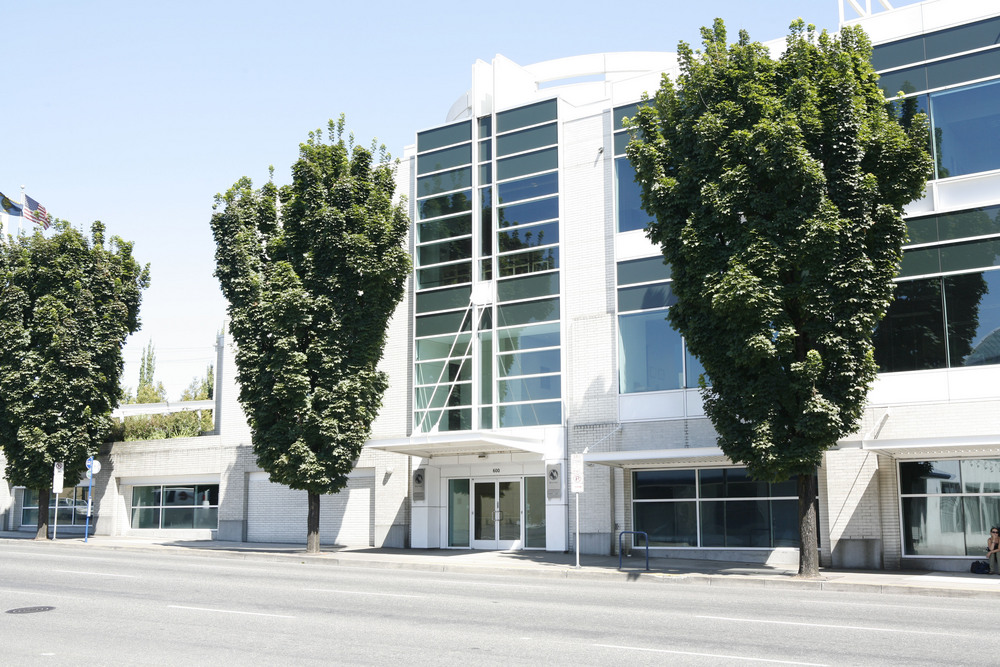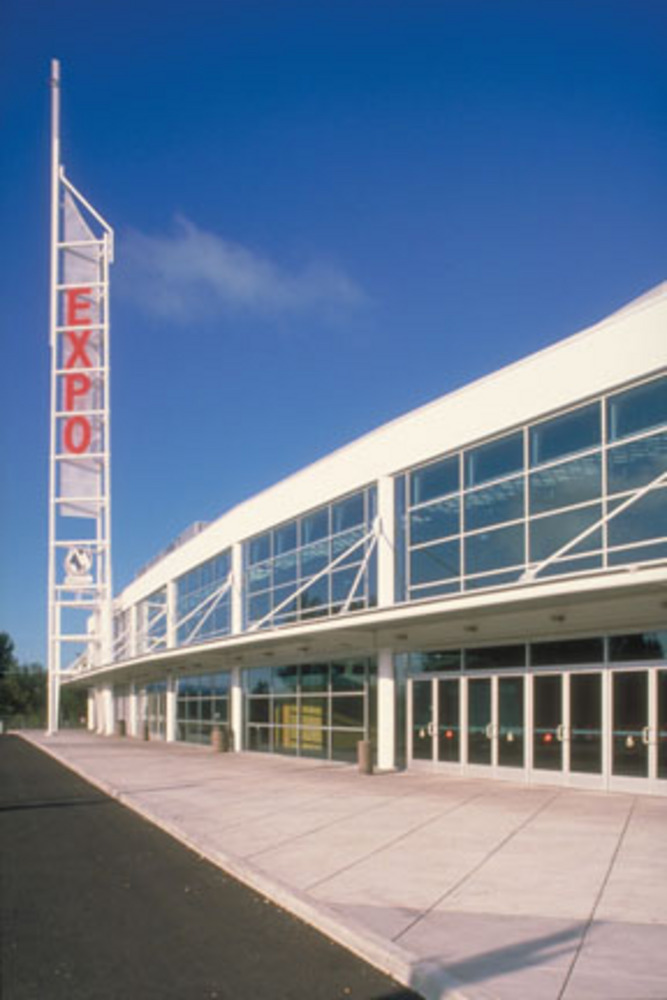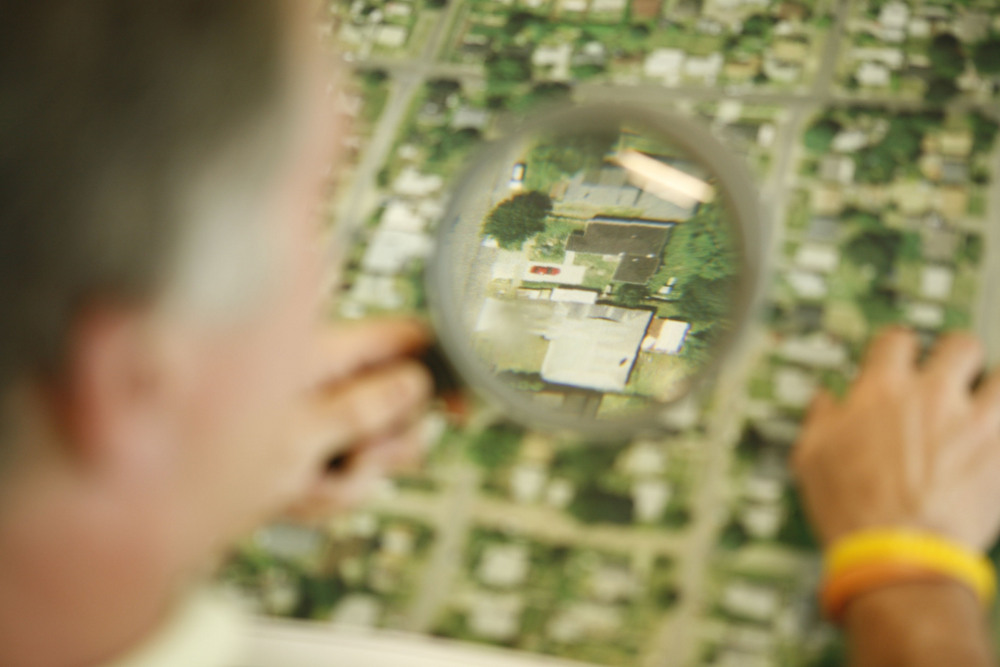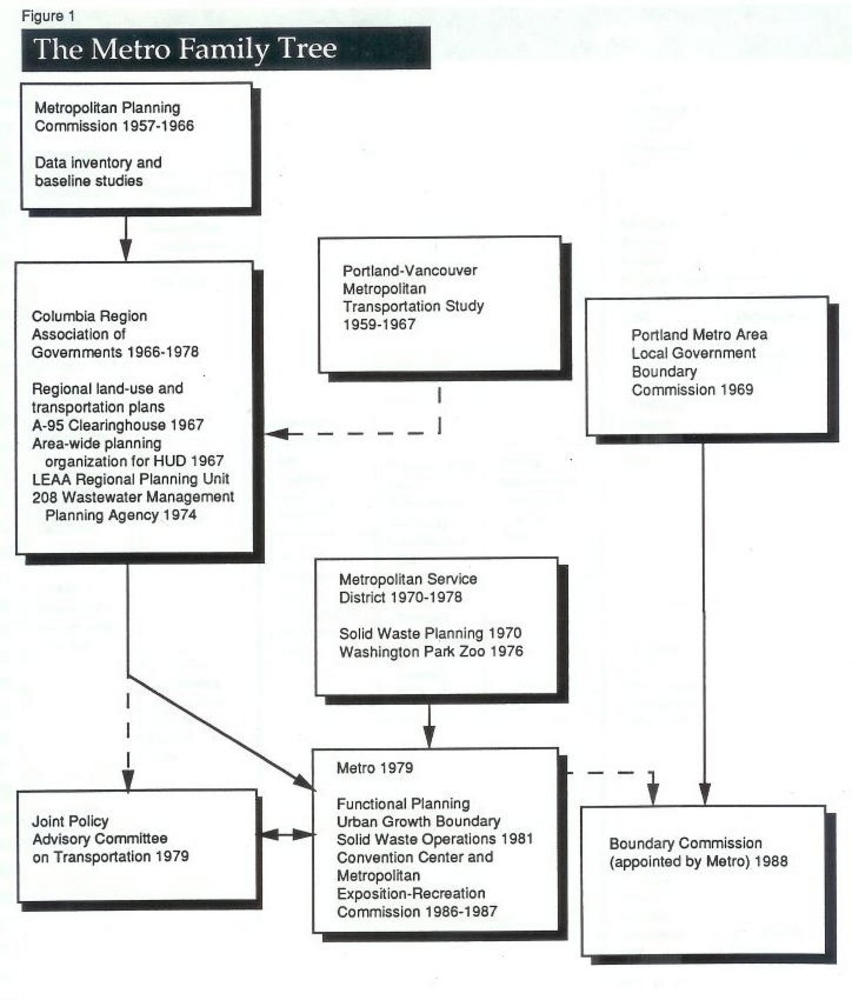Metro is a regional agency that serves the urbanized portions of Multnomah, Clackamas, and Washington counties. It deals with land use and transportation planning and administers a grab bag of regional services.
The roots of Metro lie in the Metropolitan Planning Commission (1957-1966), which undertook data inventory and studies of economic and land-use conditions. In 1966, the organization evolved into the Columbia Region Association of Governments. CRAG (1966-1978) was a regional planning agency on the "council of governments" model, in which the governing bodies of counties and municipalities named representatives in a sort of miniature United Nations.
CRAG met the federal requirements that transportation, housing, and sanitation planning be coordinated on a regional basis before federal funds could be allocated to improve infrastructure. From 1966 to 1974, local governments could choose whether or not to be part of CRAG; participation was mandated by legislative action from 1974 to 1978. In 1970, the legislature created the Metropolitan Service District, or MSD (1970-1978), which was responsible for solid-waste planning and, after 1976, the Washington Park Zoo.
Several other regional agencies were created during this period. In 1963, the legislature established the Portland Metropolitan Study Commission, which functioned until 1971. The commission facilitated the creation of CRAG and MSD and assisted in the consolidation of four fire districts in Multnomah County and the Columbia-Willamette Air Pollution Authority in 1968 (soon absorbed into the new Oregon Department of Environmental Quality). The Tri-County Metropolitan Transportation District, or Tri-Met, dates from 1969. The Port of Portland and the Commission of Public Docks consolidated in 1970 and expanded into a three-county agency in 1974.
In 1975-1976, the National Academy for Public Administration used funds from the U.S. Department of Housing and Urban Development to fund the Tri-County Local Government Commission. The commission, in turn, developed a proposal to merge CRAG into MSD, which already had statutory authority to provide direct services. The most creative and innovative aspect of the proposal was the direct election of the governing council from districts. The 1977 legislative session approved sending the proposal to the voters, although suburban representatives shrank its coverage from the entire three counties to those areas already urbanized, or likely to be so.
Residents of the three counties approved the changes by 20,000 votes in May 1978, and CRAG was folded into the MSD. Majorities in Multnomah and Washington counties carried the measure over opposition from Clackamas County. Because the ballot measure title began with the words "Abolish CRAG," it is unclear what portion of voters expected to get a weaker regional agency rather than one that was potentially much stronger. The agency's governing body soon changed the official name to Metro. Since January 1979, Metro has remained the only directly elected regional government for any United States metropolitan area.
Originally, Metro had a directly elected executive officer and a twelve-member council. The district boundaries were drawn to cross city and county boundaries, so that councilors would see themselves as direct representatives of the citizens rather than as agents of pre-existing units of local government (analogous to members of the state legislature). Executive officers elected under this structure were Rick Gustafson (1979-1986) and Rena Cusma (1987-1994). Metro bought and renovated an empty Sears store on Northeast Grand Avenue and moved its offices into the building in 1993.
In 1992, voters adopted a home-rule charter for Metro that reduced the number of councilors to seven and created an independently elected auditor. Mike Burton (1995-2002) was the executive officer under this system.
The most recent structural change to Metro came with charter amendments that went into effect in 2003. The new arrangement abandons the separation of powers model for something analogous to a mayor-council system. The council now consists of six members elected from districts and a council president (David Bragdon, 2003- ) elected at large. The council president sets agendas and makes appointments to all Metro committees, board, and commissions.
Metro's major responsibilities can be grouped into six categories.
1. Land-use planning. Metro is the regional land-use planning agency. Its Urban Growth Management Functional Plan (1996) and Regional Framework Plan (1997) guide cities and counties in preparing their own plans. The plans implement the Region 2040 Growth Concept that Metro adopted in 1995 following a comprehensive process of technical analysis and citizen input. The 2040 model envisions a region with a strong center in downtown Portland, eight "regional centers" such as Hillsboro, "town centers" such as St. Johns and Lake Oswego, and "main streets" such as Sandy Boulevard.
Metro is also responsible for setting the state-mandated urban growth boundary (UGB) for the three-county metropolitan region. By state law, the UGB is supposed to include enough residential, commercial, and industrial land to meet projected twenty-year needs. Because the first boundary was drawn somewhat generously, there was little pressure on land supply until the region emerged from the recession of the 1980s and began a period of fast growth. In response, Metro substantially expanded the area within the UGB in 1998 and again in 2002. Decisions about the UGB are among the most controversial of Metro's actions because of their potential effect on land values and the character of rural districts.
2. Transportation planning. Metro is the federally recognized agency for coordinating and recommending regional transportation decisions. A Joint Policy Advisory Committee on Transportation, consisting of elected officials, operates under the agency's auspices.
3. Open space. In 1994, Multnomah County transferred several county-owned parks to Metro, and the agency won approval of a $135 million tax levy for open-space acquisition in 1995. Voters approved an additional levy of $227 million in 2006. By September 2008, the agency had acquired roughly 9,000 acres, much of it land at the edge of urbanized areas or just beyond.
4. Oregon Zoo. The Washington Park Zoo was one of the first responsibilities given to the original MSD. At the time, the City of Portland was glad to be rid of a money sump. Since then, Metro has renamed the facility the Oregon Zoo and worked to improve exhibits and increase visitors.
5. Convention and performance venues. Through the Exposition-Recreation Commission, Metro owns and manages the Portland Center for the Performing Arts, the Oregon Convention Center, and the Portland Metropolitan Exposition Center in North Portland.
6. Solid waste planning and disposal. Household garbage, construction debris, and other trash in the metropolitan area are collected by private haulers, and Metro is responsible for the disposal of the collected materials. Since 1990, the bulk of this material has been trucked to a large landfill in Gilliam County. Metro works with local governments to encourage recycling and maintains waste transfer facilities in Oregon City and Northwest Portland for commercial haulers and individuals.
-
![]()
Metro Regional Center, 600 NE Grand Ave., Portland.
Courtesy Metro
-
![]()
Metro Regional Center, 600 NE Grand Ave., Portland.
Courtesy Metro
-
![]()
Chendra the Asian elephant at the Oregon Zoo, owned and operated by Metro..
Courtesy Metro
-
![]()
Veterinarian Dr. Lisa Harrenstien teaching conservation at Oregon Zoo.
Courtesy Metro
-
![]()
Metro planning initiatives to provide commuter options.
Courtesy Metro
-
![]()
Metro's natural gardening programs are part of the toxics reduction initiative..
Courtesy Metro
-
![Metro owns and operates the Portland Metropolitan Exposition Center (pictured) and Oregon Convention Center and operates the Portland Center for the Performing Arts.]()
Metro Expo Center.
Metro owns and operates the Portland Metropolitan Exposition Center (pictured) and Oregon Convention Center and operates the Portland Center for the Performing Arts. Courtesy Metro
-
![]()
Lone Fir Cemetery, Portland Metro.
Courtesy Metro
-
![]()
Analyzing mapping data, Metro Research Center, Portland..
Courtesy Metro
-
![]()
Metro's recycling education and outreach..
Courtesy Metro
-
![]()
Workers sorting materials for recovery at Metro's solid waste transfer station, Portland..
Courtesy Metro
-
![Metro has produced the 100% recycled MetroPaint brand since 1992.]()
MetroPaint.
Metro has produced the 100% recycled MetroPaint brand since 1992. Photo copyright Jerome Hart, courtesy Metro
-
Metro organizational "family tree".
Map This on the Oregon History WayFinder
The Oregon History Wayfinder is an interactive map that identifies significant places, people, and events in Oregon history.
Further Reading
Abbott, Carl, and Margery Post Abbott. Historical Development of the Metropolitan Service District. May 1991.













